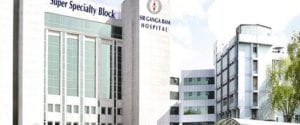Best Doctors in India for Cervical Spinal Stenosis Treatment
Best Hospitals in India for Cervical Spinal Stenosis Treatment
- City: Bengaluru, India
Hospital Highlights:
- Fortis Hospital Bannerghatta, Bengaluru was established in 2006.
- The hospital is a 276 bedded multi-specialty tertiary care facility.
- The hospital specializes in cutting-edge medical technology and dedicated patient care services.
- The hospital is equipped with state-of-the-art technologies like trans-radial angioplasty, trans-abdominal cardiac surgery, and computerized TKR navigation surgery.
- The hospital provides specialty medical services in cardiology, cardiac surgery, orthopedics, neurology, neuro-surgery, GI, and Minimal Access Surgery (MAS).
- City: Chennai, India
Hospital Highlights:
- Fortis Malar was established in 1992 and was formerly known as Malar Hospital.
- The hospital specializes in cutting-edge medical technology and dedicated patient care services.
- The hospital is multi-specialty, tertiary care facility with 180 beds.
- The hospital offers comprehensive medical care in specialties such as cardiology, cardio-thoracic surgery, neurology, neurosurgery, orthopedics, nephrology, gynecology, gastroenterology, urology, pediatrics, and diabetes.
- City: New Delhi, India
Hospital Highlights:
- Established in 1996, Pushpawati Singhania Research Institute is one of the top hospitals in the NCR region, as well as one of the top facilities in India for gastroenterology. The hospital is one of South Asia’s first institutes in medical and surgical treatment for diseases related to digestion.
- The hospital is equipped with state-of-the art facilities coupled with the latest equipment as well as renowned consultants from various parts of India as well as other parts of the world.
- City: New Delhi, India
Hospital Highlights:
- State-of-the-art technology and devoted healthcare professionals have been brought together under one roof at Venkateshwar Hospital to provide genuine medical care. The hospital’s professionals work together as a team to deliver the best possible treatment to their patients, using the most sophisticated equipment and information technology.
- Venkateshwar Hospital’s mission is to attain global excellence in healthcare by employing evidence-based, ethical clinical practices and cutting-edge technology by a team of highly skilled experts.
- City: New Delhi, India
Hospital Highlights:
- Sir Ganga Ram Hospital, New Delhi is known to provide the latest medical procedures with the latest technology in all of its units.
- The hospital has a team of reputed doctors, nurses, and healthcare professionals that ensure that patients receive quality care at affordable costs.
- Staffed with a team of highly qualified doctors, dedicated nurses, and paramedical and non-medical staff, the hospital aims to lead in healthcare delivery, medical education, training, and research.
- As per the vision of the founder, the hospital also provides free treatment to the economically weaker sections of society.
- Sir Ganga Ram Hospital also provides training to young doctors under the Diplomate in National Board(DNB) program. The DNB program at the hospital was started in 1984 and it is known for currently running the maximum number of DNB specialties in the country. It also has the distinction of having the first bone bank in India.
- City: Kerala, India
Hospital Highlights:
- Established in 2019, Apollo Adlux Hospital is the first Apollo Hospital in Kerala and the 73rd hospital owned by Apollo Group in India. With the state’s most advanced, comprehensive healthcare infrastructure and cutting-edge technologies, Apollo Adlux Hospital stands as an example of medical excellence in Kerala.
- With over 34 multi-specialty departments, the hospital believes in providing the best quality treatment to its patients at affordable rates, ensuring comfort at their difficult times.
- The 300-bed hospital is managed by a team of highly qualified and experienced experts who delivers exceptional hospitality to their patients and treats them with great compassion.
- With its affiliation with the Apollo Hospitals Group, the hospital aims in providing patients with top-notch healthcare services while also serving communities in Kerala.
- The hospital has good railway and road connections, and is conveniently close to Cochin International Airport.
- City: Gurugram, India
Hospital Highlights:
- Situated near DLF Cyber City, Gurugram, Narayana Superspecialty Hospital is one of the top medical facilities in the Delhi NCR region, catering to the needs of the people. Known for its commitment to quality medical care and patient service, the hospital is a state-of-the-art facility with planned and well-equipped sections, which includes a spacious OPD area as well as comfortable patient rooms.
- It is the closest super-specialty hospital from Indira Gandhi International Airport towards Gurugram, and also the nearest super specialty hospital from DLF Cyber City. It is also close to major residential areas in Gurugram.
- It is part of the renowned Narayana Health Group. Established in 2000, by Dr. Devi Shetty, a renowned cardiac surgeon, it has grown to be one fo India’s leading healthcare groups.
- City: Noida, India
Hospital Highlights:
- Fortis Hospital, Noida, stands as one of the oldest and most trusted healthcare institutions in the region, setting a benchmark for comprehensive medical care.
- As the second mega hub hospital in the Fortis Healthcare Group, Fortis Hospital, Noida, upholds a legacy of trust among more than 1.2 million patients. By integrating top-tier professionals with cutting-edge technology, the hospital delivers superior treatment across various medical disciplines.
- Specializing in advanced Neurosciences, Orthopedics, Kidney and Liver Transplant Programmes, Fortis Hospital, Noida has successfully performed over 1,500 transplants, solidifying its reputation as a leader in specialized medical interventions.
Spinal Stenosis
Spinal stenosis is a condition that occurs when the space around the spinal cord narrows down and causes pressure on the nerve roots. This is usually caused by wear-and-tear arthritis. As the cartilage wears away, and a bone rubs against other bones, this can result in overgrowth of other bones that can intrude into space of the spinal cord. It usually occurs in the lower back and the neck.
Spinal stenosis can also be caused by herniated disks, thickened ligaments as well as abnormal growths. It can be caused by Paget’s disease or major trauma to the spine as well. As you age, you are more likely to develop this illness. It usually occurs in people who are over 60 years of age. People with this illness can sometimes show no symptoms, and sometimes show symptoms such as back pain or numbness or weakness in the legs.
Types of Spinal Stenosis
Usually, there are two main types of spinal stenosis, which include-
Cervical stenosis: In this condition, the narrowing is seen to occur in the part of the spine in the neck.
Lumbar stenosis: In this condition, which is the more common form, the narrowing occurs in the spine in the lower back.
Symptoms of Spinal Stenosis
Even though some people can see evidence of their spinal stenosis, on an MRI or a CT, they don’t experience any symptoms. However, when they occur, they start gradually and over time they get worse. Symptoms can vary depending on the location of the ailment and the nerves that have been affected.
Symptoms of Cervical Stenosis include:
- Tingling or weakness or numbness in one hand, arm, foot or leg
- Experiencing problems while walking and balancing
- Pain in the neck
- Bowel or bladder dysfunction in severe cases
Symptoms of Lumbar Stenosis include:
- Tingling or numbness in a foot or leg
- Weakness in a leg or foot
- Pain or cramping in one or both of the legs when you stand for longer periods, or when you walk
- Pain in the back
Causes of Spinal Stenosis
Overgrowth of bone- Wear and tear damage caused by osteoarthritis on your spinal bones can lead to the formation of bone spurs, which may then grow into the spinal canal. A bone diseas known as Paget’s disease, which usually affects adults can also cause bone overgrowth in the spine.
Herniated disks- The soft cushions which act as shock absorbers between your vertebrae can dry out as you age. Cracks in the exterior of a disk can allow some of the soft inner material to escape and also press on the spinal cord or nerves.
Spinal Injuries- Sometimes an accident or trauma can lead to dislocations or fractures in one or more vertebrae. The bone which has been displaced from the fracture can also lead to damage to the contents of the spinal canal.
Thickened ligaments- The tough cords that aid in holding the bones of your spine together can eventually become stiff as well as thickened. These thickened ligaments can eventually bulge into the spinal canal as well.
Tumors- Abnormal growths may also form inside your spinal cord within the membranes which cover the spinal cord or in the space between the spinal cord and vertebrae. These can be easily identified on spine imaging using an MRI or CT.
Diagnosis of Spinal Stenosis
X-rays
MRI
CT scan
Treatment options for Spinal Stenosis
Physical Exercises
People with spinal stenosis can feel that they are in too much pain to exercise or perform any physical activity. However, movement is extremely important for your overall health, which is why some form of exercise is important even if it’s just for a few minutes per day.
If you find exercising extremely difficult, you can try it in a pool, as the buoyancy of the water can help you to move easily as well as get in a full range of motion.
Other than regular movement, massage therapy can also loosen up your back muscles along with providing relaxation.
Surgery
Surgery is considered as an option when all other treatments have failed to help or if you have been disabled due to your symptoms. The goal of surgery is to relieve the pressure on your spinal cord or nerve roots by creating more space within the spinal canal. To resolve symptoms of spinal stenosis, surgery to decompress the area of stenosis is one of the most definitive ways.
According to research, spine surgeries can result in fewer complications when it is done by highly experienced surgeons.
There are different surgical procedures that are performed to treat spinal stenosis, which include-
Laminectomy
Laminectomy removes the back part of the vertebra which is affected. It is also termed as decompression surgery, since it helps in easing the pressure on the nerves by creating more space around them. There are also some cases where the vertebra might need to be linked to adjoining vertebrae with metal hardware as well as a bone graft, in order to help in maintaining the spine strength.
Laminoplasty
Laminotomy
Minimally invasive surgery

Risks and complications
It is quite important that you treat spinal stenosis; if left untreated, it can lead to permanent complications such as numbness, weakness, incontinence, balance problems or even paralysis.














